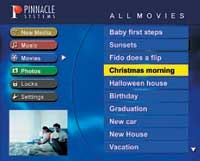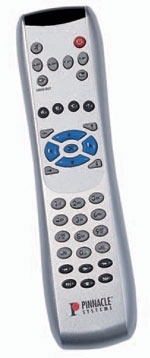Streaming for Your Pleasure Page 2
Pinnacle ShowCenter In a stylish metallic pizza-box format with blue LEDs, the Pinnacle ShowCenter Digital Media Player brings PC-stored video, audio, and photos to the living room with minimal fuss. It can work with either a wired or wireless network and has all the connectors you'll need to hook into your A/V gear. But it has a few wrinkles to iron out.
In a stylish metallic pizza-box format with blue LEDs, the Pinnacle ShowCenter Digital Media Player brings PC-stored video, audio, and photos to the living room with minimal fuss. It can work with either a wired or wireless network and has all the connectors you'll need to hook into your A/V gear. But it has a few wrinkles to iron out.
Setup is straightforward. You install media-server software on your Windows PC and connect the ShowCenter to your home network using either the supplied long Ethernet cable or an add-on PC Card for an 802.11b Wi-Fi wireless network. (You can buy the PC Card from Pinnacle for $40 or use one from an approved list on its Web site. Pinnacle expected to be selling an 802.11g Wi-Fi card and to support other cards in that format by May.) If you don't have a home network, no problem: Pinnacle also slips a crossover Ethernet cable into the box so you can plug the ShowCenter directly into the back of a PC. I connected the composite-video and analog stereo outputs to A/V inputs on the surround receiver in my home theater system. 
 The software installation automatically imports playlists and media from Windows Media Player 9. When you power up your ShowCenter in front of your TV, you briefly see your computer in a media server list, then up flashes a menu of media playing options. Using the 39-key remote control, you navigate among audio, video, and photo lists. The nav buttons in the middle of the remote let you flip between the most recently added files (New Media), audio files, video files, and still pictures, which you can view as slide shows.
The software installation automatically imports playlists and media from Windows Media Player 9. When you power up your ShowCenter in front of your TV, you briefly see your computer in a media server list, then up flashes a menu of media playing options. Using the 39-key remote control, you navigate among audio, video, and photo lists. The nav buttons in the middle of the remote let you flip between the most recently added files (New Media), audio files, video files, and still pictures, which you can view as slide shows.
The ShowCenter PC application covers a lot of ground in one screen using file-folder-style tabs. Click on the Import tab, and you can add New Media from digital cameras, CDs, or drives or folders on your computer. You can assign keywords (such as Party or Relaxation) to a song to fit a mood. You can also set restrictions, like putting certain tracks off-limits to your kids (or parents!). Once you're finished setting things up, you can just close the ShowCenter PC application. A separate and much smaller program, which runs automatically whenever you start up Windows, serves your media files to the ShowCenter hardware.
Back at the TV, ShowCenter performed pretty well, though the remote control was fussy even with fresh batteries installed. It worked most reliably when aimed directly at the ShowCenter - pointing it at anything more than about 20° off-axis often had no effect.
Most of my test video and audio files worked fine. My MP3 and WMA files sounded crisp - and the fidelity was much better on my audio system than from my PC's speaker system. My MPEG-1, MPEG-2, and DivX files played without a hitch. The system also accepts Xvid files as a native format, but DV files from camcorders and the WMV files used by Windows Movie Maker will be converted to your choice of MPEG-1 or MPEG-2. As for photo viewing, you're always looking at JPEG images scaled to standard-definition resolution (720 x 480 pixels) on ShowCenter, but if your computer also has GIF, BMP, or PNG files on it, they'll be converted to JPEGs before they're sent to the player. TIFFs need not apply, since they aren't accepted.
Once you get the hang of hitting the Full Screen button for videos, ShowCenter handles swapping between different media types without a hitch. (If you don't press Full Screen, the videos play in a tiny frame at the bottom of the screen.) The Music, Movies, and Photos buttons near the top of the remote take you straight to those collections, and a fourth named button takes you to the default Home screen. (Unlike the Netgear MP101, ShowCenter recognizes only one computer at a time, so you'll have to aggregate your collections on one "server" machine if you want to search for all your media in a home with multiple computers.)
If you don't change any settings, ShowCenter fits videos to the size and shape of your TV screen, which doesn't always work well - videos in widescreen are arbitrarily truncated. But in the setup menu you can choose to let your videos retain their original size. The video quality looked okay. Pinnacle claims that ShowCenter is compatible with video streamed at up to 10 Mbps, which would be DVD quality.
Pinnacle does a good job of updating the built-in programming in its hardware. ShowCenter finds these so-called firmware updates automatically using your network's Internet connection and pops up a notice on your TV recommending that you install them. Equally helpful is the New Media LED on the front panel, which glows to remind you of content added on your PC.
ShowCenter handles WAV and WMA files by converting them on the fly to MP3, and it keeps a replica of the Windows My Music folder populated entirely with MP3 files. Problem is, I have several thousand WMA files, and this mirrored music folder ate up more than 6.5 GB of storage space in MP3 duplicates. Ouch!
To preserve hard-disk space, it would be better if ShowCenter read WMA files in their native format. And faster wireless networking (as noted earlier, 802.11g support was expected by May) will make high-bit-rate video playback more reliable and less prone to occasional dropped frames. Interestingly, as we went to press we learned about several new features in Version 1.5 (also expected in May): Internet radio and the ability to control a Pinnacle PCTV tuner and recorder card in your computer from ShowCenter.
The idea is that without leaving the living-room sofa, you should be able to command your bedroom PC to schedule a recording, then stream it over your home network to your TV. Given that kind of evolving functionality, ShowCenter provides a cost-effective way to introduce digital media into your TV-watching mix. - M.L.
- Log in or register to post comments





























































